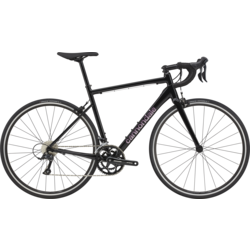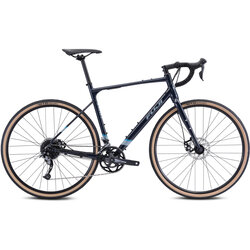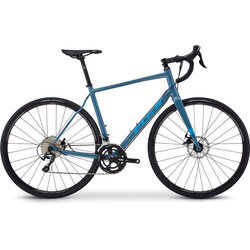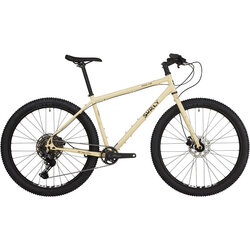New To Road Riding? Start Smart!
Are you wondering how to get into the sport of road riding? You've come to the right place. We love the camaraderie, the joyful, easy speed, and the amazing fitness benefits of riding the road. But don't be fooled. Regardless of what you may have heard, good road riders aren't made from logging lots of miles, but rather from mastering some basic techniques, like those explained here. Even if you haven't been on two wheels since your 10th birthday, follow our tips and you'll be riding like an experienced, knowledgeable rider and enjoying the wide-open road in no time.
Focus It might seem obvious, but roadies need to focus while riding, and, the ability to focus on the right things could be the most important step in becoming a safe, smooth and efficient cyclist.
It might seem obvious, but roadies need to focus while riding, and, the ability to focus on the right things could be the most important step in becoming a safe, smooth and efficient cyclist.
For example, you should focus on yourself, other riders, traffic, pedestrians, changes in the terrain, and anything that puts you at risk, like potholes, grates, railroad tracks and road debris. Always scan the road ahead and watch for these things, ride only as fast as is safe for the conditions, and avoid all dangerous obstacles.
It's also important to monitor your position on the road and stay as far to the right as is safe and practical. Please never ride against traffic or in the middle of the lane (unless you're descending at the same speed as traffic or need to to avoid hazards).
Something that helps your focus and safety is keeping your head up. We know it feels fun and fast to lower your head and fly down the road, but, with other road users, parked cars, cracked pavement, etc. it's just too dangerous. So don't stare down at your front tire, at your cyclo-computer or your newly muscled legs — keep your eyes up and on what's ahead. And, try to limit looking at the scenery or your speedometer to quick looks, similar to checking the rearview mirror while driving. By keeping the right focus, you'll stay safe.
Tip 1: Keep your head up and your eyes focused 10 to 20 feet up the road. Scan for obstacles, pavement cracks, potholes, pedestrians, rocks and glass. By looking up the road, you'll have time to avoid these obstacles.
Tip 2: Put eyes in the back of your head. Consider mounting a cycling mirror on your bars, glasses or helmet so you can see what's behind. Or learn to turn your head to look back while riding. The trick is to do this while riding straight and not swerve as you look back. We have a nice selection of mirrors and can tell you which is best for you and your bike.
Relax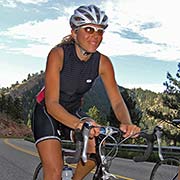 Relaxed roadies handle their bicycles better, go faster with less effort and enjoy every ride a lot more. Very few things do more to improve your overall road riding.
Relaxed roadies handle their bicycles better, go faster with less effort and enjoy every ride a lot more. Very few things do more to improve your overall road riding.
Start by loosening up your arms. Bend your elbows slightly so that you have a 5-to-90-degree bend. This turns your upper body into a natural shock absorber when you hit a bump, pothole or crack. And, because your arms absorb road shocks, you also won't go over the bars or crash.
Next try to loosen your shoulder, neck and back muscles. If you need a visual aid, imagine those muscles turning into Jell-O. Now that your whole upper body is relaxed, you'll be be able to handle your bike better and your bike will follow your eyes, not the bumps of the road.
Don't forget to relax your grip on the bars too. You don't want to strangle them. Just hold tight enough that your hands won't come off if you hit bumps. Be sure to change your hand position regularly, too.
Relaxing like this lets you ride a lot more easily. Don't believe us? Find a small climb, tense your back, neck, shoulders, elbows and hands. Now ride up it as fast as you can. With that miserable experience over, relax all those muscles and try again. We're sure that you'll get up your climb with a lot less effort now that you're riding relaxed.
Tip: Smile! A simple smile can send a signal to your whole body to loosen up.
Tip 2: Shake your arms out. If your arms are getting tight, take one arm off the bar and shake it out, and repeat with the other. This relieves tension and restores blood flow preventing numbness.
Riding With Others Road riding gets even more fun when you pedal with pals, and a few tips will help here too, Keep in mind that while it's great to be strong, fit and fast out there on the road, it's how well you ride with others that really shows your mastery of road riding. So, it's worth it to practice a bit and get comfortable around other roadies.
Road riding gets even more fun when you pedal with pals, and a few tips will help here too, Keep in mind that while it's great to be strong, fit and fast out there on the road, it's how well you ride with others that really shows your mastery of road riding. So, it's worth it to practice a bit and get comfortable around other roadies.
The best way to start is to practice "drafting" with one other rider. Drafting is riding behind another rider who breaks the wind while you save energy in the slipstream behind. It's one of the most important skills to perfect because all good riders do it and you want to too or you'll tire out before they do.
To work on this fun and important technique, find a traffic-free stretch of road (or empty parking lot) and a helpful friend. Start riding slowly at first, say 10-12 mph, and practice keeping your front wheel 1-2 feet directly behind your friend's rear wheel. As you get comfortable maintaining this distance, increase the speed slightly. It might sound fast now, but you'll easily learn to draft at more than 20mph, and the faster you go, the more energy the person in back saves.
Drafting takes focus too. Work on getting comfortable staying a certain distance from your partner without staring at his rear wheel. Instead, watch his shoulders. It takes a little pratice, but in time you'll be able to stay the same distance away just like you can with cars when driving in heavy traffic. Another good skill is looking around and past the rider in front to see what's up the road. He should tell you about any obstacles, but it's good to keep your eyes on the road ahead too.
Once you're riding in groups and drafting, always keep in mind that the rider in front of you may do something unexpected, like swerving, coasting or even stopping suddenly. To be prepared and safe, be sure he knows you're back there. If he's not comfortable with you drafting him, find someone who is. Then pay constant attention to the body posture of your draft provider. A loose, relaxed rider is less likely to swerve suddenly. A rider whose arms are locked straight is more likely to suffer mishap when they hit rough pavement. A rider whose shoulders are hunched and breathing hard is more likely to stop suddenly. Soon, you'll process this information subconsciously and be able to join even large group rides and draft comfortably while you enjoy the fun conversation in the group.
Tip 1: Place your hands in the hooks (the highest part of the bar's drops) so that you have great control and access to braking and shifting while riding in a paceline. It's the safest place for your hands. Placing your hands on the hoods is a close substitute.
Tip 2: Try a "no-drop" group ride. These will ensure friendly help and usually, a smaller pack of riders.
Don't Coast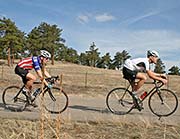 You're puffing up a steep grade, the sweat is rolling off your brow and the gear you're pushing just seems so hard. It's very tempting to stop pedaling and coast. The problem is that soon you'll start rolling backward. Also, coasting while climbing only creates more work because you lose all momentum. So, instead, select your easiest gear and try to keep a smooth pedal stroke up that steep grade.
You're puffing up a steep grade, the sweat is rolling off your brow and the gear you're pushing just seems so hard. It's very tempting to stop pedaling and coast. The problem is that soon you'll start rolling backward. Also, coasting while climbing only creates more work because you lose all momentum. So, instead, select your easiest gear and try to keep a smooth pedal stroke up that steep grade.
And, if you're always finding yourself in your lowest gear, you may want to consider a larger cassette or a different crankset, two nice ways to lower your bike's climbing gears. We're happy to explain the options and set you up for easier climbing.
Surprisingly, you don't want to coast down every hill either. Sure, if you're alone on a sweet descent, and there are no other cyclists (or cars) in sight, go ahead and fly as fast as you like. But, if you're ahead of other riders, you should only coast through tight corners. The reason is that as you go down a hill, your relative draft is huge. This means that the rider behind you (and they don't even have to be that close), is riding with much, much less effort than you are and if you coast at the front they're likely to need to hit the brakes. And, your slight change of speed will seem like a brick wall just popped up in front of them. So, keep pedaling when you're around other riders and, if you get tired, pedal easily while moving predictably to one side or the other. The rider behind you will get to go to the front and you'll get a nice rest in their draft.
Tip 1: Don't let anyone tell you that you're riding a "wimpy" gear. There's no such thing. Whatever gear lets you spin comfortably over the top of the hill is the right gear.
Tip 2: You'll generate more power if you focus on and practice your pedaling. The trick is pedaling on the downstroke and upstroke so that you're not using energy to lift the leg that just reached the bottom of the pedal stroke. To perfect this technique, shift down a gear or two and focus on pulling your feet backward and upward when they reach the bottom of the stroke, as if you were scraping mud off the bottom of your shoes. Now, envision yourself pedaling circles not squares. Pedaling this way saves energy and boosts your climbing power too.
Don't Push A Huge Gear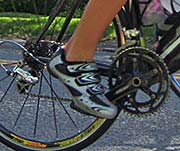 One of the most common errors we see in new cyclists is that they try to muscle a huge gear up hills and into headwinds. This is a very ineffective way to ride that fatigues you more quickly and might eventually cause injury.
One of the most common errors we see in new cyclists is that they try to muscle a huge gear up hills and into headwinds. This is a very ineffective way to ride that fatigues you more quickly and might eventually cause injury.
Cycling is perceived as an aerobic sport like running, but this isn't entirely accurate. Cycling requires tremendous muscular effort which creates an aerobic (or anaerobic) reaction from your lungs. But, measurement of your muscular force is the best gauge of cycling effort — and cycling fatigue. For this reason, it's important to pace yourself well so that you still have energy and strength left at the end of your rides. And the best way to do this is to spin smaller gears.
So try to keep your pedal stroke supple and fluid no matter what the terrain does. The more you can do this, the longer your legs will last and the further you can go.
It's much easier to maintain a fluid pedal stroke if you have a clipless pedal system. Like ski bindings, this system uses shoes with cleats that clicks into your pedals. This connection allows you to pedal all the way through the pedal stroke, adding power on the upstroke as well. It takes a little time to get used to clipless pedals, but they're more efficient and safer than pedals with clips and straps or flat pedals. We have a wide selection of clipless pedals and shoes and can help you pick the right system.
Tip 1: Get a cycle-computer with cadence. Cadence measures how many revolutions per minute your legs make. Shoot for a cadence of 90 rpm. Some riders feel more comfortable at 80, others at 100, so shoot for 90, and find what works for you.
Tip 2: Shift down before you come to stop signs or lights, too. This ensures that you're in a gear that lets you accelerate easily as you cross the intersection.
Look The Part, Feel The Part Now that you're comfortable with your bike, traffic and other riders, it's time to put on the finishing touches. Get a cycling kit that includes a helmet, jersey, shorts and gloves, and you'll look and feel like a real road rider.
Now that you're comfortable with your bike, traffic and other riders, it's time to put on the finishing touches. Get a cycling kit that includes a helmet, jersey, shorts and gloves, and you'll look and feel like a real road rider.
Cycling shorts might be the most important part of your outfit. They're light, will make you feel more comfortable in the saddle, fit snugly for aerodynamics and wick moisture so you don't have to sit in a puddle. We've got shorts for all types and sizes of riders. For the road, consider bib shorts because they don't have any constrictive waist elastic. If you're uncomfortable in Lycra, we also have baggy shorts that include a liner short, with a casual, stylish outer short that's as good-looking in the office as it is out on the road.
The cycling jersey is another important part of looking and feeling like an experienced road rider. Don't wear that cotton T-shirt. It will get wet, and stay that way. Plus, the less-than-form-fitting T can rub and chafe. Instead, pick out a comfortable, cycling jersey that fits you well. It will breathe and wick to keep you dry, it's aerodynamic and won't catch the wind slowing you down and most jerseys are brightly colored to keep you safe out on the road too. Some even include reflective details for safety. Plus, most road jerseys have pockets in back so you can easily grab food, your cell phone and other items while you ride. There's usually no need for a backpack. For the fashion conscious, note that we have matching jerseys, shorts and gloves — sometimes helmets too!
Tip 1: Cycling shorts are made to be worn next to your skin. No underwear is needed.
Tip 2: Consider a new helmet if yours is more than three years old. Helmets get more fragile with age. Plus, each year helmets get lighter, cooler and safer.




